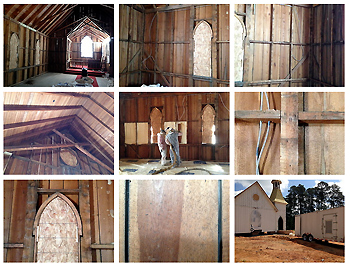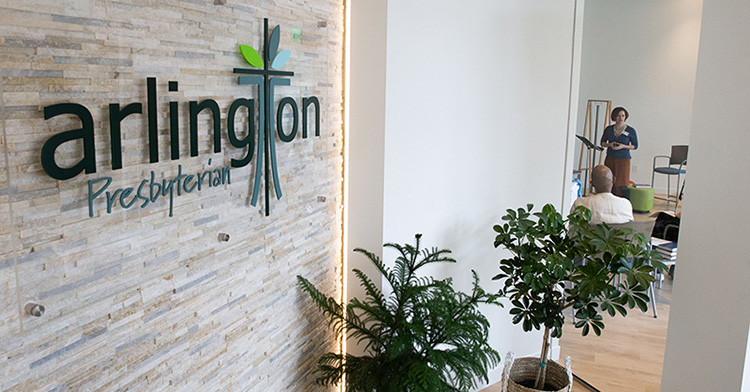From the beginning, our congregation has been intentional about developing new ways of being.
The Church of the Advocate in Chapel Hill, N.C., was founded in 2003 as a mission church of the Episcopal Diocese of North Carolina. Well aware of ourselves as a 21st-century mission within the Anglican Episcopal tradition, we earnestly considered the call to remain a nomadic church.
We developed our website and our presence in social media; we got involved in the community and held our service at 5 p.m. each Sunday. We rented space in a Unity church and a synagogue. We got creative with outdoor processions downtown, held meetings in one another’s homes.
We took seriously our belief that the church is not a building but the people of God, the body of Christ.
But after six years, the task of setting up and taking down our worship space every week was losing its charm. More importantly, we realized what a more-permanent location could provide for us and for our ministry.
We wanted to offer a variety of opportunities for prayer, contemplation and worship. We wanted to offer hospitality throughout the week. We wanted to plant community gardens and invite people into public space to organize and be empowered to work for God’s compassionate justice in the world. We wanted buildings with “porous walls,” inviting people to come and go freely.
We purchased 15 acres of land through the generosity of our congregation and donors and developed a vision for a nonprofit center, an intentional community and more.
But first, we needed a building in which to worship. Despite big dreams, we were a small congregation without much money.
As we considered our options, the Diocesan Historic Properties Committee approached us about St. Philip’s Church, an unused historic building in Germanton, N.C. Would we consider moving it?
The Carpenter Gothic, board-and-batten church, built in 1891, was listed on the National Register of Historic Places. Its simple architecture was exemplary of the 19th-century rural church. And it had never had electricity or plumbing.
It could seat 150, but its congregation had dwindled, and in 1980 it came under the care of the historic properties committee. For 20 years, locals kept up the building and held two services a year, but eventually those services ceased. Now a Baptist congregation wanted to purchase the land, and the diocese was looking for someone to move the structure.
The idea resonated deeply with the Church of the Advocate congregation. As a people committed to environmental sustainability, we realized that reusing an existing structure was much preferable to constructing a new one.
For some, the building held a certain retro appeal; for others, it was nostalgic. For all, it represented our commitment to cherish the past while making it new, to be rooted in tradition but not bound by it.
We also heard a call to allow the building itself to flourish, to be used for the purpose for which it was constructed, to be a place of worship and hospitality for a growing, vital congregation.
This led us to a tangle, though -- heartfelt opposition from some who lived in and around Germanton.
While the Episcopalians of Germanton had long since died or moved away, several people of the region were attached to the church. It was a visual touchstone for them, a place they identified with their small town.
The Episcopal Diocese of North Carolina legally owned the building. But the people who lived in and around Germanton had visually “owned” it for more than 100 years.
The conflict was painful for everyone. But the Advocate’s emerging passion for making the building accessible to all in all seasons of the year, combined with the matter of legal ownership by the diocese, held sway.
Thus began the actual and the metaphorical process of “moving church.”
Traveling 120 miles on back roads with a 122-year-old building is no simple task. Every mile of the route had to be approved by local jurisdictions; branches were trimmed, roads were closed and police escorts arranged.
Stained-glass windows were stored for safekeeping, and movers took down the bell tower and roof so they wouldn’t hit overhead lines.
As the building was taken apart for transport, it revealed previously invisible rot and decay. This church didn’t just need preservation; it needed renewal. At each step we had to determine which parts were unfit for restoration, which could be restored and which needed to be rebuilt with new lumber and nails.
The night before the building rolled onto its new location, a group from the Advocate went out to its berth by the highway and prayed. We celebrated “a church on the move” and realized that we were being formed for our future.
It has been 10 months since the building arrived at its new home. The foundation has been built, there are new shingles on the roof, and the beadboard walls have been removed, insulated and returned.
The stained-glass windows have been reinstalled. Only the window that faces liturgical east will be different. It will be clear glass now and will be called the Vision Window, in thanksgiving for those whose vision and perseverance brought the building to this place.
The old wood stove will become a credence table, holding the vessels for the people gathered, offering a different kind of warmth.
We still have to provide some infrastructure -- parking lot, curbs, sidewalks and sewer -- before we get the coveted certificate of occupancy.
But even then, I pray that we will not settle.
The building has arrived, but the church keeps moving, as long as we are open to the Spirit and alert to the world around us. If so, we will continue to cultivate gardens and to build porous walls.
Carefully and patiently, we will examine our old structures and ways to determine which have rotted and can no longer function, which need to be preserved as they are and which can be moved and restored, made new for a new generation and accessible to all.
Moving a 19th-century building across three counties was exciting. But moving church, the people of God, is by far the greater work.









